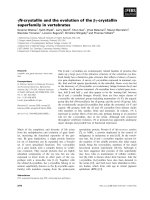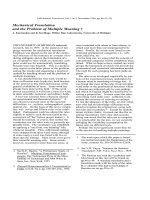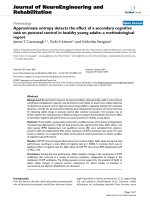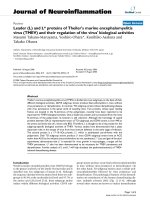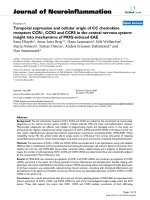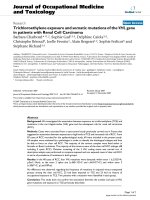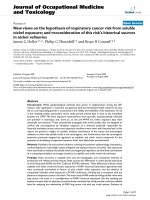Báo cáo hóa học: " Gold nanowires and the effect of impurities" doc
Bạn đang xem bản rút gọn của tài liệu. Xem và tải ngay bản đầy đủ của tài liệu tại đây (296.83 KB, 8 trang )
Abstract Metal nanowires and in particular gold
nanowires have received a great deal of attention in the
past few years. Experiments on gold nanowires have
prompted theory and simulation to help answer ques-
tions posed by these studies. Here we present results of
computer simulations for the formation, evolution and
breaking of very thin Au nanowires. We also discuss
the influence of contaminants, such as atoms and small
molecules, and their effect on the structural and
mechanical properties of these nanowires.
PACS 71.15 m Æ 71.15.Fv Æ 71.15.Nc
Introduction
Modern experimental techniques such as Scanning
Tunneling Microscopy (STM), Atomic Force Micros-
copy (AFM) and High Resolution Transmission Elec-
tron Microscopy (HRTEM) that allow visualization
and, more importantly, manipulation of individual
atoms, made possible nanoscience. Along with these
new possibilities new challenges were presented to
science, and one way to complement the understanding
of these new questions is the use of computer simula-
tions, such as molecular dynamics, that in the last few
years have also evolved a great deal due to the com-
puter capability of present computers as well as the
improvement of algorithms. These new simulation
methods, implemented at levels ranging from effective
potentials to tight binding based, up to ab initio elec-
tronic structure, have helped to aid the understanding
of experiments as well as stimulate new experiments,
since these techniques now have predictive power. The
research in basic and applied science which is associ-
ated with the development of devices at nanoscale
makes the study of nanowires and nanocontacts of
paramount importance. The reason is that nanosized
devices require nanosize contacts. The interesting fact
is that at this size scale, the behavior of nanowires is
different than the metal in bulk form. Atomic size
metal nanowires exhibit, for example, quantized con-
ductance and increase in reactivity and strength,
among other interesting properties.
Atomic size wires can be produced via a variety of
techniques, e.g., if a metallic tip is retracted from a
metallic surface [1]. Suspended monoatomic nanowires
have been detected with the use of controllable
breaking junctions [2], atomic force microscopy [3] and
are imaged with high resolution transmission electron
microscopy [4]. Using this HRTEM technique, real
time evolution of nanowires can be observed. For these
reasons theoretical studies of such systems have been
intense.
Metallic nanowires were in fact predicted by simu-
lations. Mostly using molecular dynamics with classical
many body potentials, simulations have predicted new
structures [5, 6]. An interesting example of a proposal
of new structures is the work of Gulseren, Ercolessi
and Tosatti [6] that have predicted, based in computer
simulations for classical potentials, that Al and Pb thin
E. Z. da Silva (&)
Instituto de Fı
´
sica ‘‘Gleb Wataghin’’, UNICAMP,
CP 6165, 13083-970 Campinas, SP, Brazil
e-mail: zacarias@ifi.unicamp.br
F. D. Novaes Æ A. J. R. da Silva Æ A. Fazzio
Instituto de Fı
´
sica, USP,
CP 66318, 05315-970 Sa
˜
o Paulo, SP, Brazil
Nanoscale Res Lett (2006) 1:91–98
DOI 10.1007/s11671-006-9018-4
123
NANO REVIEW
Gold nanowires and the effect of impurities
Edison Z. da Silva Æ Frederico D. Novaes Æ
Antoˆ nio J. R. da Silva Æ A. Fazzio
Published online: 1 August 2006
Ó to the authors 2006
wires would prefer to have what they called weird
structures as opposed to the expected crystalline mul-
tifaceted structures.
The research in computer simulations for metallic
nanowires is been pursued using a variety of tech-
niques, and the present work focus on the use of two
ones based on Density Functional Theory (DFT) [7, 8].
Tight binding molecular dynamics (TBMD) is used for
the dynamical evolution of the NWs and DFT elec-
tronic structure methods, using either localized
(SIESTA code) or plane waves (VASP code) basis set,
are used to study the final stages of evolution of these
wires, as well as the effect of contamination with light
impurities.
Methods
The tight-binding molecular dynamics method explic-
itly includes the electronic structure, but is much faster
than first principles methods. Of course, this gain in
speed comes with the cost of loosing some of the
flexibility of fully ab initio methods. The TBMD basi-
cally divides the problem of the dynamical evolution of
a system into two, namely: (a) The TB accurate
parametrization for the system of interest [9]; and (b)
Use of this basis set to calculate the quantum forces to
be used in the MD calculation [10]. Since the used basis
sets are usually much smaller than in full ab initio
calculations, the required matrix diagonalizations are
performed much faster.
Therefore, to study the full evolution from a thicker
rod, and breaking of a gold nanowire, we have per-
formed TBMD simulations [9, 10]. Details of the pro-
cedure we used can be found in Refs. [9–11]. Very
briefly, the electronic structure of gold is described
using a TB fit developed by Mehl and Papaconstanto-
poulos [9], which gave very good results when applied
to bulk solid and liquid gold, for both static as well as
dynamic properties [10]. The electronic structure was
calculated using a diagonalization procedure, and the
equations of motion along the MD procedure were
integrated using the Verlet algorithm with a time step
of Dt = 1 fs. To perform the annealing, we have used a
friction parameter c = 0.001 fs
–1
. Brillouin zone sam-
pling was done using the G-point. The periodic super-
cells used in all calculations had dimensions (20 A
˚
,
20 A
˚
, L
W
).
In order do supplement our understanding of these
thin NWs we have also used first principles DFT [7,
8] methods to the final stages of the evolution and
breaking of the wires previously obtained with the
TBMD. The reasons for it were two-fold; first ab
initio calculations could confirm the TBMD results
and, further, they could add information on the
electronic structure of the atoms near breaking.
Second, using ab initio methods we could study the
effect of light impurities and their effect on the
structural and mechanical properties of Au NWs.
These questions were therefore answered by ab initio
total energy DFT calculations for selected structures
from the TBMD simulations. Two methods have
been used; in some cases we have used a description
of the Kohn–Sham orbitals based on a localized basis
set, via the SIESTA code [12], which is a fully self-
consistent procedure for solving the Kohn–Sham
equations [13]. The interaction between the valence
electrons and ionic cores are described through
standard norm-conserving Troullier–Martins pseudo-
potentials [14]. Periodic boundary conditions were
used with a supercell approximation with lateral
separation of 20 A
˚
between wires to make sure that
they do not interact with each other. We have used
the X-point for the Brillouin zone sampling (tests
with 8 Monkhorst–Pack k-points [15] along the tube
axis were also performed with similar results). After
each change in the wire’s length, the positions of all
the atoms in the supercell were relaxed until all the
forces were smaller than 0.03 eV/A
˚
. Calculations
were done within the generalized gradient approxi-
mation (GGA) [16] for the exchange-correlation
functional. Split-valence double-zeta basis set with
polarization function, with a confining energy shift of
0.07 eV [17], and a cutoff of 250 Ry for the grid
integration [12], were used (a series of tests for both
bulk gold and gold dimer gave us confidence that
these were appropriate choice). GGA breaking forces
for pure Au NWs are in good agreement with the
experimental results (1.9 nN, and the experimental
result [18] is 1.5 ± 0.3 nN).
Besides the DFT calculations using localized basis
set, we have also used a plane waves (PW) basis set
to expand the Kohn–Sham orbitals and density. We
have employed the VASP code [19], within the GGA
approximation [20], with ultrasoft pseudopotentials
[21] and a plane wave expansion up to 180 eV. All
other approximations were the same as in the
SIESTA calculations. These SIESTA and VASP
calculations for pure Au NWs provided results that
were very similar, and also similar to the previous
TBMD results [22]. They served on the other hand to
give us more insight into the mechanism of bonding
as well as into the electronic structure of these wires
[22], and have shown that indeed the breaking
distances in pure Au nanowires are not bigger than
3.0–3.1 A
˚
.
92 Nanoscale Res Lett (2006) 1:91–98
123
Evolution and breaking
TBMD simulations were used to study the evolution of
Au wires [11, 22, 23] in an attempt to understand
experiments that show atomically thin NWs. As an
example, one of such simulations is discussed here. We
considered a NW composed of a stack of ten (111)
planes of seven atoms each, to study the evolution of
gold nanowires under stress. The periodic super-cell
had an initial length L
W
= 24.0 A
˚
along the tube
direction. After one thermalization cycle, the initial
configuration attained a cylindrical final geometry with
the external atoms reconstructing into a densely
packed structure. After this thermalization procedure,
we repeated cycles where the wire was elongated by
0.5 A
˚
, the temperature was increased to 300 K, and the
system was annealed for 4,000 MD steps (4 ps) until a
temperature of approximately 30 K was reached. This
cycle was repeated until the rupture of the wires. In
general terms, the thinning down process is due to a
defect structure that leads to the one atom constriction
[11, 22, 23]. Once the one atom constriction that sep-
arates the two tips is formed, a new process is initiated.
Atoms from only one of the tips start to move to the
neck, and are incorporated to the one dimensional
chain that grows as long as five atoms from apex to
apex, with three suspended atoms. The details of the
neck formation are presented in Ref. [22].
It is very instructive to follow the structural evolu-
tion of the NW if the pulling forces are displayed along
with the selected structures. From the total energies of
the final configurations of each elongation stage, these
forces were obtained. Similarly to recent studies of
mechanical properties associated with the formation
mechanisms of atomically thin Au nanowires [18], we
observe that the dynamical evolution of the nanowires
correspond to elastic stages followed by sudden struc-
tural relaxations, which are reflected in a sawtooth
behavior of the pulling force acting on the wire, as can
be seen [22, 23] in Fig. 1 for this simulation.
The simulation presents a feature similar to other
ones [22], which is a tendency of the NW to become
hollow as it is pulled; this is caused by the motion of
atoms from the center of the wire towards its surface,
showing that this is a general feature of this type of
evolution. As a consequence, the seven-atom planes
have a tendency to be transformed into six-atom rings
stacked along the tube axis, in the evolution defected
parts of the wire start to distort and narrow sections
develop. The result is the formation of narrow con-
strictions that develop into a line of suspended atoms
attached to Au atoms from the two leads. From the
insets in Fig. 1, it can be seen that the elastic stages
correspond to the building up of stress mostly due to
the increase of the interatomic distances. The force
relaxations, on the other hand, correspond to either
concerted rearrangements of the atoms, mainly at the
defective part of the wire (for example the formation
of the one atom thick neck occurs mainly in the elon-
gation interval from L
W
= 36.5 A
˚
to L
W
=38A
˚
), or
due to the insertion of a new atom into the chain, after
the one atom constriction was formed. After elonga-
tion L
W
=38A
˚
, the NW shows the incorporation of
other suspended atoms and also displays an one atom
wire sideways movement, as the wire grows with
incorporation of more atoms. We obtain a value for the
applied force right before the breaking of the nanowire
around 1.5 nN for this simulation. These results are in
good agreement with the experimental value [18]of
1.5 ± 0.3 nN. The final structure in Fig. 1 depicts the
wire just after its rupture.
Au NWs obtained using the TBMD gave very nice
results and helped the understanding of processes
associated with their evolution. Au–Au distances just
prior to breaking of the wire, that we refer in short as
breaking distances, were all around 3 A
˚
.
Further tests to verify that those were indeed the
correct values for the Au–Au breaking distances were
done using selected structures from the TBMD calcu-
lations. The configurations used had already five neck
atoms, but the sizes of the wires were smaller than the
TBMD rupture point. The further evolution all the way
to breaking was accomplished using ab initio DFT
methods. As mentioned above, both SIESTA and
VASP codes were used, and no qualitative changes
were observed. Breaking distances and breaking forces
were all similar within all three methods. This gave us
confidence that we had very reliable structures, and
Fig. 1 Calculated pulling force acting on the Au nanowire for
selected stages of the simulation. Arrows indicate configurations
after major structural rearrangements of the wire
Nanoscale Res Lett (2006) 1:91–98 93
123
that the presented results were not artifacts of the
method used.
Effect of impurities
Au in bulk form is a very stable metal, and this is the
main reason for its use as electric contact. The extreme
situation presented by these new atomically thin wires
deserves investigation, as to what extent impurities
would affect the pure NW. Intentional contamination,
and more importantly, non-intentional ones, could very
well happen inside of even very good vacuum cham-
bers, where some of the experiments are performed.
The research on pure metals NWs have been
intense, however, the study of impurities in these sys-
tems has increased mostly in the last few years. In fact,
from both a fundamental and applied perspectives, it is
a natural line of investigation the understanding of how
other atomic and molecular species affect the
mechanical, structural and electrical properties of these
NWs. This line of research may be viewed as ‘‘nanoc-
atalysis’’. In this context, research has focus on gold
nanostructures [24–26], that have been found experi-
mentally, as well as theoretically, to exhibit catalytic
properties.
Investigations of the behavior of NWs contaminated
by atomic and molecular species have appeared in the
literature. Some examples are the studies of metal
NWs in solution [27, 28], and the theoretical investi-
gation of the effect of small molecules, such as thiol
[29], or atomic species, such as hydrogen, carbon,
oxygen, and sulfur [30], focusing in the possibility that
such impurities could be responsible for the experi-
mentally observed, in HRTEM [31] measurements,
large Au–Au distances of @3.6 A
˚
. These works have
focused in the fact that HRTEM experiments do not
show the presence of possible contaminant light
impurities. Attempts to answer this question using
intentional doping with selected species have been also
pursued [32, 33].
We have been studying the interaction of light
impurities and small molecules with Au nanowires,
and we have focused on how these impurities may
alter the mechanical properties of these NWs. In fact,
it is an interesting result that a single atom, for
example, oxygen, when inserted in the NW neck can
produce a drastic effect on the properties of the pure
system. In order to study this problem, we have per-
formed first principles calculations using the two basis
set expansions mentioned previously for pure nano-
wires. The first calculations with impurities were per-
formed by bringing the impurity nearby the one atom
chain. We observed that the impurity was, eventually,
incorporated into the one atom chain. Due to this re-
sult, in all further studies with impurities we have in-
cluded them directly along the chain line [30].
Therefore, contaminated structures were generated for
the nanowires in the following way: Starting from an
ab initio configuration for the pure NW prior to the
rupture, as discussed above, we inserted the desired
impurity in the neck, after which all the atoms were
allowed to relax. After insertion of the impurity and
relaxation of forces, the obtained structure was pulled
until rupture, similarly to the pure case discussed in the
last section. In all cases studied, the wire never broke
in the Au–X bond (X represents an impurity). This
seems to be a general property of all the single
impurities that we have investigated. See Ref. [30] for
more details. Many different impurities [30, 34] were
studied; C, H, O, N, B, and S, and some small mole-
cules; CH, CH
2
and H
2
. We discuss some of them here.
Hydrogen is an impurity that even under ultra high
vacuum conditions might be present and, therefore,
could be incorporated into the NW. H is therefore a
possible candidate to be found in Au nanowires. Using
VASP we have investigated a variety of structures with
different number of H atoms inserted in the neck of the
NW, as shown in Fig. 2. We first considered contami-
nation by one single H in the NW. In Fig. 2a we depict
the structure prior to the rupture, and in Fig. 2b after
the breaking. The relevant interatomic distances are
presented in Table 1. As can be seen, the Au–H–Au
distance prior to breaking has a value of approximately
3.6 A
˚
(a similar result was also obtained [30] using the
SIESTA code, as shown in Table 1). This is a strong
indication that unless the experimental set up will
disrupt the structure of the NW, it seems that H would
Fig. 2 Final stages of evolution of Au nanowires with different
numbers of inserted H impurities (using VASP code). Numbers
label the atoms that are in the neck and bond distances are given
in Table 1.(a) and (b) show the wire with only one H atom just
before and after the rupture, respectively. (c) and (d) show
similar configurations for two H atoms
94 Nanoscale Res Lett (2006) 1:91–98
123
be the most likely impurity responsible for the mea-
sured Au–Au distances in the range of 3.5–3.6 A
˚
.
To further argue our case, we proceeded to include
more H atoms in the NW’s neck. In Fig. 2c and d, we
present configurations for the Au NW just before and
just after the breaking, respectively, with two inserted
H atoms in neighboring Au–Au bonds. When two H
atoms contaminate the NW with an arrangement
Au–H–Au–H–Au, we obtain two similar distances of
3.6 A
˚
, in reasonable agreement with experimental re-
sults of Ref. 31.
So far there are still no experiments that can directly
probe the nanowires to answer the question which, if
any, impurities are causing the large Au–Au distances.
Attempts of intentional doping may help, but indirect
information provided by another type of experiment
recently performed have shed some light into this
problem. Zahai et al. [35] have performed experiments
with Au clusters obtained from bulk Au. These
experiments have shown that the only clusters that
incorporate H are Au dimers. Furthermore, they have
shown that a linear structure Au–H–Au is stable, and
gives an Au–Au distance of 3.44 A
˚
, which compares
rather well with our results for H in Au nanowires if we
consider the different environments, and the fact that
the dimer is not under stress. If such dimers, as those
produced by Zahai et al. were part of a nanowire under
tension, it is reasonable to imagine that they would
give the observed experimental values around 3.6 A
˚
.
We believe that these experiments point to H as a
possible contaminant in Au nanowires, and very likely
the one responsible for the large Au–Au distances. As
a final point, we have also calculated the maximum
pulling forces for the H-contaminated wires, and they
are in the range of 1.6–1.7 nN [34].
Carbon is also a possible contaminant, and probably
for this reason, it was considered as a likely candidate
to explain the large Au–Au distances [36]. In order to
check if that could be the case, we have studied C in
many different configurations in the NW neck; we
considered structures with five and four Au atoms in
the neck, and for this latter geometry, the C was taken
either in a symmetrical or an asymmetrical position. As
in the case of H, the initial relaxed geometries of the
wires were quasi-statically pulled all the way up to their
rupture. In all cases, the behavior of C as a contami-
nant was to make the Au–C–Au bond of the order of
3.85–3.9 A
˚
[34], values that are larger than the exper-
imentally reported values of 3.5–3.6 A
˚
. The Au–C
distances remain almost constant during the stretch of
the wires, with values close to 1.9 A
˚
. Here we show one
example of such calculations using VASP. Figure 3a
shows a gold nanowire with a C atom inserted between
the Au atoms labeled 1 and 2, therefore, in an asym-
metric position in the NW. The Au–C–Au is a very stiff
bond that results in an Au–C–Au distance of 3.85 A
˚
,
with the breaking occurring at the 3–4 bond, as shown
in Fig. 3b. The Au–Au bond that breaks attains a
maximum interatomic distance of 3.05 A
˚
, and the
pulling force prior to rupture is 1.36 nN. Both these
values are similar to what is obtained for pure NWs,
which is what should be, since the rupture occurs in a
pure Au–Au bond in both cases.
For the same reason as carbon, oxygen was one of
the impurities that we have investigated (using SIES-
TA), in order to see if it could be responsible for the
large Au–X–Au distances. As it turned out, the Au–O–
Au distance too was too large, and therefore O would
not be the contaminant responsible for the observed
Au–X–Au around 3.6 A
˚
. Nevertheless, it turned out to
be a very interesting system. Oxygen that is not reac-
Table 1 Bond distances (i,j) (in A
˚
) between the atoms Au
i
and
Au
j
in the neck of the structures with inserted H impurities
shown in Fig. 2a and c
NW (1,2) (2,3) (3,4) (4,5) F (nN)
a 3.04 2.84 3.6 2.84 1.71
Ref. [30] 3.06 2.82 3.62 2.87 1.7
c 3.05 2.81 3.58 3.62 1.58
Breaking forces are also presented. The bold face distances mark
the bond where the wires break. We show, for comparison, the
results [30] for calculations with one H impurity obtained using
the SIESTA code
Fig. 3 Final stages of evolution of Au NW with C impurity using
the VASP code. Numbers refer to the Au atoms in the neck and
bond distances and angles are given in the text. (a) is the
structure with C, just prior to rupture, whereas (b) is the same
NW after the breaking
Nanoscale Res Lett (2006) 1:91–98 95
123
tive to Au even in Au surfaces, can become signifi-
cantly more reactive when gold forms small clusters, or
nanowires under tension [37]. Here we considered the
effect of the contamination of one O atom to an Au
NW with 4 atoms in the neck. The final stages of the
evolution of the NW with one O impurity are displayed
in Fig. 4, for a sequence of configurations of the wire
all the way up to its rupture.
One property of oxygen that puts it apart from all
other impurities studied, is the fact that metal atoms
were extracted from the tip, as shown in Fig. 4a
through Fig. 4c. Figure 4a displays the nanowire after
O contamination in a symmetrical configuration, in the
middle of the four Au neck atoms. Figure 4b shows the
bond Au
1
–Au
3
starting to break, and in Fig. 4c, after
tip rearrangements, the Au
2
atom is also extracted
from the tip, and atom Au
1
becomes the first neck
atom. This neck-tip reconstruction releases the stress in
the NW, and is characterized by a sudden drop in the
pulling force, as shown in Table 2. We observe that
after this stress release, as the neck becomes larger, it
forms a zig-zag structure with angles Au
2
–Au
3
–Au
4
of
129° and Au–O–Au of 135°, as can be seen in the
second view of Fig. 4c. As the wire is pulled, these
angles open up, and in Fig. 4d they are 162° and 162°,
respectively. This straightening of the structure con-
tinues until the breaking of the wire. Once again, the
rupture occurs at an Au–Au bond with the force
around 1.7 nN, a result within the experimental value
of 1.5 ± 0.3 nN, which is expected since for a pure Au–
Au bond breaking.
Au tips have a rather stable configuration, as already
discussed [11]. In fact, all the other systems that we
have studied so far simply evolved in such a way that
one of the Au–Au bonds in the neck broke. But the
structure of the tips was never modified. From these
results, we conclude that oxygen is in some sense a
special type of impurity, since it stabilizes the neck in
such a way that upon application of stress the system
favors the removal of atoms from the tip, rather than
rupturing. This occurs because the oxygen allows the
neck to withstand larger forces when compared to the
pure nanowire, of the order of 2.3 nN, as shown in
Table 2. Therefore, what the oxygen is most likely
doing is affecting the local electronic structure of the
neck via strong covalent-like bonds, besides the
metallic bond character already present in the pure Au
wires. This prediction was made recently [38] with a
suggestion that judicious contamination with O could
help the development of longer one atom chains.
Experiments using intentional oxygen doping have
been performed, with results along the lines of our
proposal [39].
A recent calculation [40] of organic molecules
attached to an Au surface, have also observed a
behavior similar to the case of the O impurity. That
simulation showed that, when the molecular structure
is pulled out of the surface, instead of breaking
somewhere along its structure it became a composite
system, namely, a molecule attached to an Au nano-
wire, which was extracted out of the Au surface.
Similarly to the oxygen-doped nanowires simulated in
the present work, the molecule instead of breaking
when pulled out from the surface, draws out with it an
one atom thick NW with a few atoms, that upon
stretching will eventually break.
Table 2 Bond distances (i,j) (in A
˚
) between the atoms Au
i
and
Au
j
in the neck of the structures with inserted O impurities
shown in Fig. 4
NW (1,2) (1,3) (2,3) (3,4) (4,5) (5,6) F (nN)
a 2.71 3.06 2.97 2.82 4.20 2.82 2.1
b 2.71 3.17 2.99 2.84 4.21 2.84 2.3
c 2.65 – 2.66 2.59 3.70 2.61 0.4
d 2.71 – 2.73 2.63 3.89 2.66 1.1
e 2.79 – 2.98 2.69 4.07 2.73 1.7
Breaking forces are also presented. The bold face distance marks
the bond where the wire will break
Fig. 4 Final stages, (from (a)to(f)), of the evolution of an Au
nanowire with an O impurity up to its rupture (two views of each
elongation are displayed). Numbers refer to the atoms that are
involved in major rearrangements in the nanowire’s neck and tip
96 Nanoscale Res Lett (2006) 1:91–98
123
Conclusions
In this paper, we discussed some aspects of the physics
of metal NWs. We showed that the use of a few sim-
ulation methods (TBMD, ab initio DFT—SIESTA,
VASP) all based in the DFT, can help the under-
standing of many questions presented by experiments.
Moreover, we have also showed that such tools can
have predictive power, as the final example of the
possible use of O impurities to produce longer atomic
Au chains. The results of evolution of Au NWs
obtained with the use of TBMD used in conjunction
with ab initio calculations have shown that TBMD
structures are very reliable, since the conclusions from
all these calculations were very similar. In particular,
the result that breaking distances for pure Au NWs are
around 3.0–3.1 A
˚
, this result being independent of the
simulation method.
With the aim of explaining the large experimentally
observed Au–Au bonds distances of ~3.6 A
˚
, we have
studied the effect of contamination of these NWs with
light impurities. In the process of studying these con-
taminants, we have obtained very interesting results.
As to the explanation of the large observed Au–Au
bonds, the only impurity among all studied one that
gave results similar to experiments were H impurities,
and we believe, if the rupture happens in the quasi-
static limit, that it is most likely the one responsible for
the observed distances. Carbon was discarded since it
gave too large distances in this especial environment of
Au NW under stress. Oxygen, which as a candidate for
the large distances could not explain the experimental
results, gave instead a possibility of its use as extractor
of Au atoms. Therefore, we have predicted [38] that it
could be used as a tool to make longer Au atomic chain
NWs. Experimental results along these lines have been
produced [39]. This research leaves a lot of questions
still unanswered. For example, if carbon atoms are
really present in the ambient of formation of these
NWs why Au–Au distances of the order of 3.9 A
˚
,
which are the largest Au–C–Au distances that we have
obtained in our simulations, have not been experi-
mentally observed. Either C atoms cannot be incor-
porated in the necks, or other effects, like the e-beam
in the HRTEM experiments, are influencing the rup-
ture of these NWs. We intend to investigate these
issues. Also, another relevant topic, that may even help
to identify the character of these impurities, will be the
understanding of their effect on the charge transport
across these NWs. Some other important questions are
how to control the insertion of these impurities, and
also, how to make use of their novel properties in
the design of new devices. We hope that the results
presented here stimulate more theoretical, as well as
experimental work in this interesting field of metallic
NWs.
Acknowledgments The TBMD code was developed by Florian
Kirchhoff as part of the Computational Chemistry and Materials
Science Computational Technology Area (CCM CTA)’s contri-
bution to the U.S. Department of Defense CHSSI program. The
simulations were performed at the National Center for High
Performance Computing in Sa
˜
o Paulo (CENAPAD-SP). We
acknowledge support from FAPESP and CNPq;. We would like
to acknowledge fruitful discussions with D. Ugarte and V. Ro-
drigues. e-mail address: zacarias@ifi.unicamp.br
References
1. U. Landman et al., Phys. Rev. Lett. 77, 1362 (1996)
2. C.J.Muller, J.M.Ruiteenbeek, L.J. de Jongh, Phys. Rev. Lett.
69, 140 (1992)
3. H. Ohnishi, Y. Kondo, K. Takayanagi, Nature 395, 780
(1998)
4. V. Rodrigues, D. Ugarte, Phys. Rev. B 63, 073405 (2001)
5. U. Landman et al., Science 248, 454 (1990)
6. O. Gulseren, F. Ercolessi, E. Tosatti, Phys. Rev. Lett. 80,
3775 (1998)
7. P. Hohenberg, W. Kohn, Phys. Rev. 136, 864B (1964)
8. W. Kohn, Rev. Mod. Phys. 71, 1253 (1999)
9. M.J. Mehl, D.A. Papaconstantopoulos, Phys. Rev. B 54, 4519
(1996)
10. F. Kirchhoff et al., Phys. Rev. B 195,101 (2001)
11. E.Z. da Silva, A.J.R. da Silva, A. Fazzio, Phys. Rev. Lett. 87,
256102 (2001)
12. P. Ordejo
´
n, E. Artacho, J.M. Soler, Phys. Rev. B 53, 10441
(1996); D. Sa
´
nchez-Portal, P. Ordejo
´
n, E. Artacho, J.M.
Soler, Int. J. Quantum Chem. 65, 453 (1997)
13. W. Kohn, L.J. Sham, Phys. Rev. 140, 1133A (1965)
14. N. Troullier, J.L. Martins, Phys. Rev. B 43, 1993 (1991)
15. H.J. Monkhorst, J.D. Pack, Phys. Rev. B 13, 5188 (1976). For
the pure gold nanowire, the Au–Au maximum distance
changed by less than 0.03 A
˚
when the number of k-points
was changed from 1 to 8
16. J. Perdew, K. Burke, M. Ernzerhof, Phys. Rev. Lett. 77, 3865
(1996)
17. E. Artacho, D. Sa
´
nchez-Portal, P. Ordejo
´
n, A. Garcia, J.M.
Soler, Phys. Status Solidi B 215, 809 (1999)
18. G. Rubio-Bollinger, S.R. Bahn, N. Agrait, K.W. Jacobsen,
S. Vieira, Phys. Rev. Lett. 87, 26101 (2001)
19. G. Kresse, J. Hafner, Phys. Rev. B 47, R558 (1993);
G. Kresse, J. Furthmu
¨
ller, Phys. Rev. B 54, 11169 (1996)
20. J.P. Perdew, Y. Wang, Phys. Rev. B 45, 13244 (1992)
21. D. Vanderbilt, Phys. Rev. B 41, 7892 (1990)
22. E.Z. da Silva, F.D. Novaes, A.J.R. da Silva, A. Fazzio, Phys.
Rev. B 69, 115411 (2004)
23. E.Z. da Silva, A.J.R. da Silva, A. Fazzio, Comput. Mat. Sci.
30
(1–2), 73 (2004)
24. A. Sanchez, S. Abbet, A.U. Heiz, W.D. Schneider,
H. Ha
¨
kkinen, R.N. Barnett, U. Landman, J. Phys. Chem. A
103, 9573 (1999)
25. H. Ha
¨
kkinen, S. Abbet, A. Sanchez, A.U. Heiz, U. Land-
man, Angew. Chem., Int. Ed. 42, 1297 (2003)
26. . H. Ha
¨
kkinen, M Moseler, U. Landman, Phys. Rev. Lett. 89,
33401 (2002)
27. C.Z. Li, H. Sha, N.J. Tao, Phys. Rev. B 58, 6775 (1998)
Nanoscale Res Lett (2006) 1:91–98 97
123
28. C.Z. Li, X. He, A. Beogozi, J.S. Bunch, N.J. Tao, J. Appl.
Phys. Lett. 76, 1333 (2000)
29. H. Ha
¨
kkinen, R.N. Barnett, A.G. Scherbakov, U. Landman,
J. Phys. Chem. B 103, 8814(1999)
30. F.D. Novaes, E.Z. da Silva, A.J.R. da Silva, A. Fazzio, Phys.
Rev. Lett. 90, 036101(2003)
31. V. Rodrigues, D. Ugarte, Phys. Rev. B 63, 073405 (2001)
32. R.H.M. Smit, Y. Noat, C. Untiedt, N. Lang, M. Van Hemert,
J.M. van Ruitembeek, Nature 419, 906 (2002)
33. Sz. Csonka, A. Halbritter, G. Mihaly, E. Jurdik, O.I. Shi-
klyarevskii, O. Speller, H. van Kempen, Phys. Rev. Lett. 90,
116803 (2003)
34. F.D. Novaes, A.J.R. da Silva, A. Fazzio, E.Z. da Silva, Appl.
Phys. A 81, 1551 (2005)
35. H. Zahai, B. Boggavarapu, L. Wang, J. Chem Phys. 121, 8231
(2004)
36. S.B. Legoas, V. Rodrigues, D. Ugarte, D.S. Galva
˜
o, Phys.
Rev. Lett. 93, 216103 (2004)
37. S.R. Bahn, N. Lopez, J.K. Norskov, K.W. Jacobsen, Phys.
Rev. B 66, 081405 (2002)
38. F.D. Novaes, A.J.R. da Silva, E.Z. da Silva, A. Fazzio, Phys.
Rev. Lett. 96, 016104 (2006)
39. W.H.A. Thijssen, D. Marjenburgh, R.H. Bremmer, J.M. van
Ruitenbeek, Phys. Rev. Lett. 96, 026806 (2006)
40. D. Kruger, H. Fucks, R. Rousseau, D. Markx, M. Parrinello,
Phys. Rev. Lett. 89, 186402 (2002)
98 Nanoscale Res Lett (2006) 1:91–98
123
